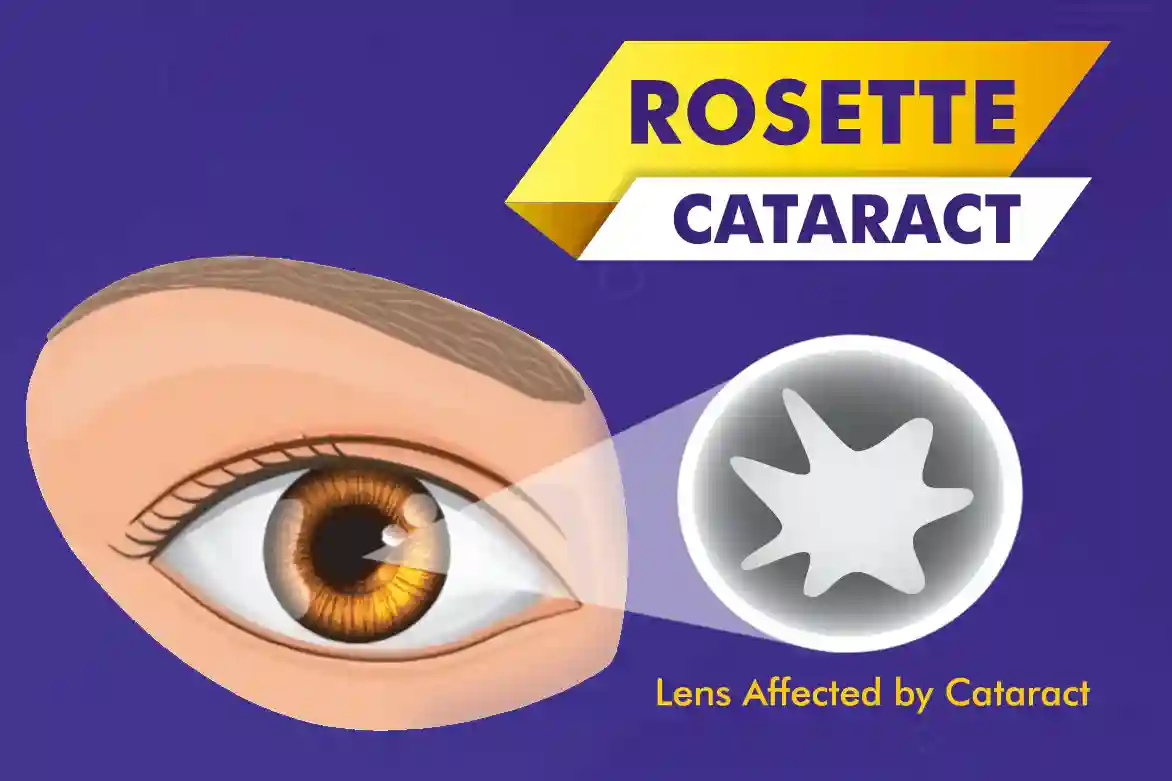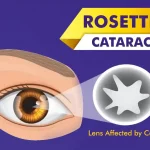What Is Rosette Cataract?
Rosette cataract is a specific type of cataract characterized by a distinctive petal-like opacity in the eye’s lens. It is often associated with trauma to the eye and forms due to disruption in the lens fibers. The appearance of rosette-shaped opacities makes it distinguishable from other types of cataracts. This condition can lead to visual disturbances, including blurred vision and difficulty with contrast perception.
Causes of Rosette Cataract
Rosette cataract is commonly linked to blunt trauma to the eye. The impact causes damage to the lens fibers, resulting in the characteristic rosette-shaped cataract. Other potential causes include:
- Ocular Trauma: A direct injury to the eye can trigger lens changes leading to a rosette cataract.
- Radiation Exposure: Certain types of radiation, such as ionizing radiation, may contribute to cataract formation.
- Congenital Conditions: Some individuals may develop early rosette cataract due to underlying genetic factors or metabolic disorders.
Symptoms of Rosette Cataract
The symptoms of rosette cataract can vary depending on the stage of development. These may include:
- Blurred or cloudy vision
- Sensitivity to light (photophobia)
- Difficulty seeing in dim lighting conditions
- Decreased contrast sensitivity
- A rosette-shaped opacity visible in advanced cases
Early rosette cataract may present with mild visual disturbances, while late rosette cataract can cause significant impairment requiring medical intervention.
How Is Rosette Cataract Diagnosed?
An ophthalmologist diagnoses rosette cataract through a comprehensive eye examination. This may include:
- Slit Lamp Examination: Allows the doctor to visualize the rosette-shaped cataract in the lens.
- Visual Acuity Test: Determines the extent of vision impairment.
- Dilated Eye Exam: Provides a detailed view of the lens and other structures in the eye.
Rosette Cataract Treatment Options
Non-Surgical Management
In early rosette cataract, vision may be managed with:
- Prescription glasses or contact lenses
- Increased lighting for reading and near tasks
- Lifestyle modifications to reduce glare and contrast issues
Surgical Treatment
If the cataract progresses and significantly affects vision, surgical intervention may be necessary. Rosette cataract treatment involves cataract surgery, which includes:
- Phacoemulsification: A common procedure where the cataract is broken into small fragments and removed.
- Intraocular Lens (IOL) Implantation: An artificial lens is implanted to restore clear vision.
Rosette Cataract Seen In Different Age Groups
While rosette cataract is primarily associated with trauma, it can also be seen in various age groups due to congenital factors, systemic diseases, or long-term medication use. It is essential to monitor symptoms and seek medical attention if vision problems arise.
Early Rosette Cataract vs. Late Rosette Cataract
Early Rosette Cataract
- May not cause noticeable vision problems
- Often detected during routine eye exams
- Managed with glasses or contact lenses
Late Rosette Cataract
- Can lead to significant vision impairment
- Requires surgical intervention in most cases
- May be associated with increased intraocular pressure
Protect your vision and maintain eye health. Schedule an Eye Examination
Conclusion
Rosette cataract is a distinct type of cataract typically associated with eye trauma. Early detection and appropriate management can help maintain vision quality. If symptoms worsen, cataract surgery may be the most effective treatment option.
FAQs
Can rosette cataract be inherited?
Yes, rosette cataract can be inherited. It is often caused by genetic mutations that affect the development and structure of the lens. If a family member has rosette cataract, there may be an increased risk of developing the condition.
Can rosette cataract be treated with medication?
No, rosette cataract cannot be treated with medication. The main treatment option is surgical removal of the affected lens and replacement with an artificial lens.
Is rosette cataract reversible?
Rosette cataract is typically not reversible. Once the opacities form in the lens, they cannot be removed without surgical intervention.
Can rosette cataract cause blindness?
Untreated rosette cataract can significantly impact vision and may lead to blindness if left untreated. However, with appropriate diagnosis and treatment, vision can be restored and the risk of blindness can be minimized.
Is rosette cataract common?
Rosette cataract is relatively rare compared to other types of cataract. Its prevalence may vary depending on the population studied and other factors. It is important to consult with an eye care professional for personalized information and advice regarding rosette cataract.
What is the difference between early and late rosette cataracts?
Early rosette cataracts have a star-shaped pattern, while late rosette cataracts show more complex formations.
What is rosette cataract?
Rosette cataracts are characterized by a flower-like pattern in the lens.
What causes a rosette-shaped cataract?
A rosette-shaped cataract is usually caused by blunt trauma to the eye, leading to lens fiber disruption and opacity formation in a distinct pattern.
How is rosette cataract seen in an eye examination?
Rosette cataract is seen in a slit-lamp examination, where its unique petal-like pattern can be observed in the lens.
Is rosette cataract treatment always surgical?
Not always. In mild cases, corrective lenses and lifestyle adjustments may help. However, if vision deteriorates, cataract surgery may be required.
What is the difference between early rosette cataract and late rosette cataract?
Early rosette cataract may not cause significant symptoms and can often be managed conservatively, while late-stage cataract can impair vision and necessitate surgery.
Can rosette cataract be prevented?
Protective eyewear can help reduce the risk of trauma-induced cataracts, and regular eye check-ups can aid in early detection and management.





